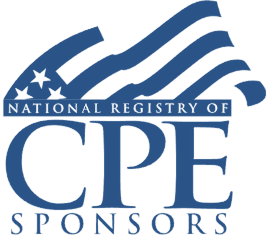Welcome! Save 30% on all CLE, CPE, and Professional Skills webinars, plus 15% off any annual pass with code HOLIDAY25
About the Course
Introduction
This course will walk tax preparers through the preparation of Form 3115, Application for Change in Accounting Method, common scenarios that require its filing, and the corresponding recognition of the adjustment under Section 481(a).
Description
Whether by new regulations, accounting method changes, or error, numerous reasons necessitate filing Form 3115 and making the corresponding Section 481(a) adjustments. Generally, if an impermissible method of accounting is used for more than one year, it must be corrected by a change of accounting method. Since a negative adjustment (a reduction in income) is taken immediately, it can generate significant cash flow for a business in the year of change. A positive Section 481(a) adjustment is taken over four years.
Some changes are automatic; these are listed regularly in a Revenue Procedure issued by the IRS (Rev Proc 2024-23 or its successor). These automatic changes provide for certain administrative efficiencies by not requiring consent by the Commissioner prior to making the change in method and not requiring a filing fee paid to the IRS.
Non-automatic changes require IRS consent before changing and payment of a filing fee to the IRS. Both types require the taxpayer to file Form 3115, Application for Change in Accounting Method. Tax practitioners working with businesses need to understand how to complete Form 3115 and report Section 481(a) adjustments on taxpayers' returns.
Listen as our panel of federal income tax experts explains what constitutes a change in accounting method, completing Form 3115, and calculating the necessary adjustment under Section 481(a) for businesses and their advisers.
Presented By

Mr. Aucoin is a principal in the tax practice at Baker Newman Noyes, specializing in serving banks and financial services institutions of all sizes as well as individual clients and their small businesses. He assists with corporate and individual tax planning, multi-state tax compliance, and tax provision compliance. Mr. Aucoin joined the firm in 2012, having previously been at a small firm in the Bangor, Maine region.
-
BARBRI is a NASBA CPE sponsor and this 110-minute webinar is accredited for 2.0 CPE credits.
-
BARBRI is an IRS-approved continuing education provider offering certified courses for Enrolled Agents (EA) and Tax Return Preparers (RTRP).
Date + Time
- event
Friday, August 15, 2025
- schedule
1:00 p.m. ET./10:00 a.m. PT
I. Changes in accounting method: an overview
II. Circumstances requiring a change in accounting method
III. Preparing Form 3115
IV. Automatic and nonautomatic changes
V. Section 481(a) adjustment
VI. Recent legislative changes
VII. Best practices
The panel will cover these and other important issues:
- What constitutes a change in accounting method and requires filing Form 3115?
- How are Section 481(a) adjustments calculated and made?
- How to deal with method changes required to be reported on a cut-off basis
- What recent updates require filing Form 3115?
Learning Objectives
After completing this course, you will be able to:
- Identify recent legislative changes that could require filing Form 3115
- Determine how to report Section 481(a) adjustments
- Decide when an error correction requires filing Form 3115
- Ascertain differences in requirements for automatic and non-automatic changes
- Field of Study: Taxes
- Level of Knowledge: Intermediate
- Advance Preparation: None
- Teaching Method: Seminar/Lecture
- Delivery Method: Group-Internet (via computer)
- Attendance Monitoring Method: Attendance is monitored electronically via a participant's PIN and through a series of attendance verification prompts displayed throughout the program
- Prerequisite:
Three years+ business or public firm experience preparing complex tax forms and schedules, supervising other preparers or accountants. Specific knowledge and understanding of pass-through taxation, including taxation of partnerships, S corporations and their respective partners and shareholders.

BARBRI, Inc. is registered with the National Association of State Boards of Accountancy (NASBA) as a sponsor of continuing professional education on the National Registry of CPE Sponsors. State boards of Accountancy have final authority on the acceptance of individual courses for CPE Credits. Complaints regarding registered sponsons may be submitted to NASBA through its website: www.nasbaregistry.org.

BARBRI is an IRS-approved continuing education provider offering certified courses for Enrolled Agents (EA) and Tax Return Preparers (RTRP).

BARBRI CE webinars-powered by Barbri-are backed by our 100% unconditional money-back guarantee: If you are not satisfied with any of our products, simply let us know and get a full refund. Contact us at 1-800-926-7926 .
Unlimited access to premium CLE courses:
- Annual access
- Available live and on-demand
- Best for attorneys and legal professionals
Unlimited access to premium CPE courses.:
- Annual access
- Available live and on-demand
- Best for CPAs and tax professionals
Unlimited access to premium CLE, CPE, Professional Skills and Practice-Ready courses.:
- Annual access
- Available live and on-demand
- Best for legal, accounting, and tax professionals
Unlimited access to Professional Skills and Practice-Ready courses:
- Annual access
- Available on-demand
- Best for new attorneys
Related Courses
Recommended Resources

How CPE Can Bridge the Gap Between What You Know and What You Need to Know
- Career Advancement



